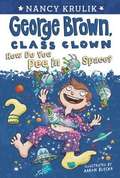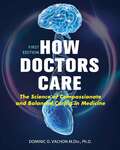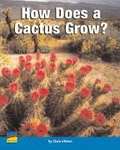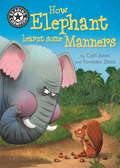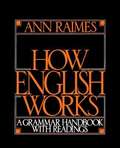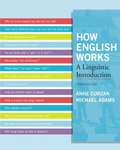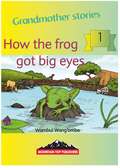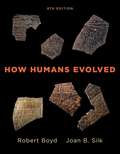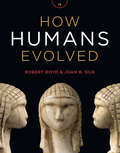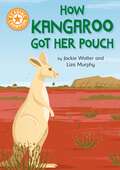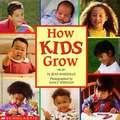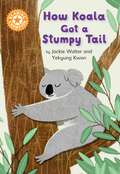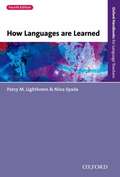- Table View
- List View
How Do You Pee in Space? #13
by Nancy Krulik Aaron BlechaA real-life astronaut is coming to Edith B. Sugarman Elementary School, and one lucky kid gets to interview him! Not only that, a trip to a space adventurer program is also up for grabs. To win the contest, students must complete a physical fitness challenge and come up with three interesting questions to ask the astronaut. As always, George intends to beat his rival, Louie. But when the competition heats up, George is too distracted to notice how much the prize means to his best friend, Alex. For George, winning may not be everything this time around.
How Doctors Care: The Science of Compassionate and Balanced Caring in Medicine
by Dominic O. VachonCompassion draws physicians into medicine, but then they believe they must jettison that compassion to survive. Paradoxically, science has now shown that losing that compassion not only harms the patient, it also harms the doctor. How Doctors Care: The Science of Compassionate and Balanced Caring in Medicine explains what physicians and other clinicians can do to provide balanced and compassionate caring for patients without becoming emotionally detached or overwhelmed. <p><p>The text provides a research-informed and non-sentimental description of physician/clinician compassion. Bringing together cutting-edge scientific research for practicing physicians and those in training, How Doctors Care provides the first full articulation of what constitutes optimal compassionate mental performance in the practice of medicine. It argues how maintaining this internal state is the key to physician resilience and fulfillment in a dysfunctional healthcare system. <p><p>Rather than blaming clinicians for burnout, How Doctors Care argues that healthcare organizations must provide organizational protection and support to clinicians so that they are able to maintain the compassionate internal state they desire so much and that benefits patients the most.
How Does a Cactus Grow?
by Clare O’brien Vicki Rushworth David HaggertyIn this book, learn how cacti grow from seeds and survive in the harsh desert environment.
How Does a Tree Help? (Into Reading, Level B)
by David Bauer<p>NIMAC-sourced textbook <p>All kinds of animals make their homes in trees. Children do, too!</p>
How Does Motion Energy Change in a Collision?: Student Activity Guide
by The Smithsonian InstitutionNIMAC-sourced textbook
How Elephant Learnt Some Manners: Independent Reading 12 (Reading Champion #511)
by Cath JonesThis story is part of Reading Champion, a series carefully linked to book bands to encourage independent reading skills, developed with Dr Sue Bodman and Glen Franklin of UCL Institute of Education (IOE). This book is aimed at Independent Reading 12, for readers aged 7 years old and up, or in the second half of Year 3.Elephant is the biggest and also thinks he's the best. He's always a bit rude to the other animals, until some clever squirrels teach him a lesson.Reading Champion offers independent reading books for children to practise and reinforce their developing reading skills.Fantastic, original stories are accompanied by engaging artwork and a reading activity. Each book has been carefully graded so that it can be matched to a child's reading ability, encouraging reading for pleasure.The Key Stage 2 Reading Champion Books are suggested for use as follows:Independent Reading 11: start of Year 3 or age 7+Independent Reading 12: end of Year 3 or age 7+Independent Reading 13: start of Year 4 or age 8+Independent Reading 14: end of Year 4 or age 8+Independent Reading 15: start of Year 5 or age 9+Independent Reading 16: end of Year 5 or age 9+Independent Reading 17: start of Year 6 or age 10+Independent Reading 18: end of Year 6 or age 10+
How Elephant Made Peanut Butter
by Lesli Favor Marcin Piwowarski Lori O'DeaHow can an elephant feed his friends? The forest animals gather for lunch, but no one has any food. Can Elephant get them to try his idea?
How English Works: A Grammar Handbook with Readings
by Ann RaimesThis book uses readings from newspapers, works of non-fiction, and college textbooks to illustrate the use of target structures. The Student's Book provides clear presentations of the basic principles of 27 important areas of English grammar, through a wide variety of exercises and tasks for writing and editing. It engages students with topics that range from artificial intelligence and laptop computers to the environment and economics. This important grammar text provides a real-world context that allows students to see how the English language really "works. "
How English Works: A Linguistic Introduction
by Martin Sandler Edwin Rozwenc Edward. Martin Michael Adams Anne CurzanThis accessible introduction to the structure of English, general theories in linguistics, and important issues in sociolinguistics, is the first introductory linguistics textbook written specifically for English instructors and educators. Focuses on issues such as American dialects, descriptive and prescriptive approaches to English grammar, the history of English, English spelling, stylistics, language attitudes, and language education. Tapping into our natural curiosity about language, it invites readers to connect academic linguistics to everyday use of the English language and to become active participants in the construction of linguistic knowledge. The third edition provides updated examples of current language change--including new slang and other word coinages, grammatical developments, and sound changes--as well as new research findings on American dialects, language acquisition, language evolution, eggcorns, English and the Internet, and much more. For anyone interested in the structure of English, general theories in linguistics, and important issues in sociolinguistics.
How The Frog Got Big Eyes
by Wambui Wang'Ombe"One day the frog was hopping around.”One two three,...... hop, four five six jumps, seven eight--!!” The frog hit an object. “Ouch! What is this?”
How Gliders Fly (Into Reading, Level J #52)
by Heather HammondsNIMAC-sourced textbook <p><p> A non-fiction explanation about non-engine powered objects that can fly: will tell readers how some non-engine powered objects fly. Text type: explanation; Genre: non-fiction
How Glooskap Found Summer and Other Curious Tales
by Lynne Benton Kristen GuerinNIMAC-sourced textbook
How Humans Evolved
by Robert Boyd Joan B. SilkThis book focuses on the processes that have shaped human evolution. As anthropologists, the authors are interested in the evolutionary history of their own species. Homo sapiens and the diversity of contemporary human societies. As evolutionary biologists, the authors study how evolution works to shape the natural world. In this book, they integrate these two perspectives and use current theoretical and empirical work in evolutionary theory, population genetics and behavioral ecology to interpret human evolutionary history. They describe the changes that have occurred as the human lineage has evolved and consider why these changes may have happened. By focusing on the processes that generate change, create adaptations and shape bodies and behavior, they try to give life to the creatures that left the bones and made the artifacts that paleontologists and archaeologists painstakingly excavate. The authors also pay serious attention to the role of evolution in shaping contemporary human behavior. The list of references for further reading at the end of each chapter provides a starting point for students who want to delve more deeply into the material covered in that chapter.
How Humans Evolved (Seventh Edition)
by Robert Boyd Joan B. SilkGive students a complete picture of human evolution.
How I Started a Clothing Drive
by Max Francis Rina Krevat Jeffrey B. FuerstThe weather is turning cold. Max wants everyone to have something warm to wear. He sets out to make his idea happen. Will his plan work?
How Kangaroo Got Her Pouch: Independent Reading Orange 6 (Reading Champion #1076)
by Jackie WalterThis story is part of Reading Champion, a series carefully linked to book bands to encourage independent reading skills, developed with Dr Sue Bodman and Glen Franklin of UCL Institute of Education (IOE)Reading Champion offers independent reading books for children to practise and reinforce their developing reading skills.Fantastic, original stories are accompanied by engaging artwork and a reading activity. Each book has been carefully graded so that it can be matched to a child's reading ability, encouraging reading for pleasure. Perfect for 5-7 year olds or those reading book band orange.
How Kids Grow
by Jean MarzolloFrom seeing and tasting to buttoning a shirt or losing a tooth, the special moments in a child's life are captured in Jean Marzollo's straightforward text. Photographer Nancy Sheehan's clear, bright images of multicultural children -- from a three-day-old infant to a cartwheeling seven-year-old -- are sure to enchant readers of all ages.
How Koala Got a Stumpy Tail: Independent Reading Orange 6 (Reading Champion #1076)
by Jackie WalterThis story is part of Reading Champion, a series carefully linked to book bands to encourage independent reading skills, developed with Dr Sue Bodman and Glen Franklin of UCL Institute of Education (IOE)Reading Champion offers independent reading books for children to practise and reinforce their developing reading skills.Fantastic, original stories are accompanied by engaging artwork and a reading activity. Each book has been carefully graded so that it can be matched to a child's reading ability, encouraging reading for pleasure. Perfect for 5-7 year olds or those reading book band orange.
How Languages Are Learned (Fourth Edition)
by Patsy M. Lightbown Nina SpadaWritten by experienced teacher trainers and language learning experts, Patsy Lightbown and Nina Spada, How Languages Are Learned relates the theories of first and second language acquisition to what actually goes on in the classroom. It uses activities to explore the practical implications of the ideas presented. Evaluations and case studies are included throughout the book so that you can see a practical context for the research ideas you are reading about. Many of these examples are taken directly from real second language classrooms. Now in its 4th edition, How Languages Are Learned is highly valued for the way it relates language acquisition theory to classroom teaching and learning and draws practical implications from research for the language classroom. It is widely used as a reference book on teacher training courses, and is for new and experienced practising teachers. New to this editionUpdated to reflect the most recent research in the field of second language teaching and learning Activities and Questions for Reflection personalise content and support critical thinkingExtra activities, study questions and videos available onlineNow also available as an ebook from Amazon, Kobo and iBookstore
